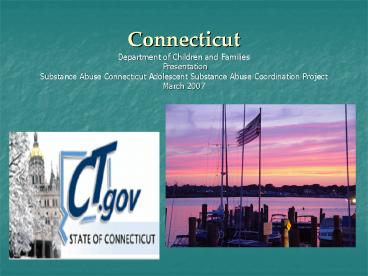Connecticut Department of Children and Families Presentation Substance Abuse Connecticut Adolescent - PowerPoint PPT Presentation
1 / 13
Title:
Connecticut Department of Children and Families Presentation Substance Abuse Connecticut Adolescent
Description:
University of Delaware. Ownership. Filed in the Name of ... University of Delaware. Timetable. Must File in US Within One Year of First ... Delaware. Trade ... – PowerPoint PPT presentation
Number of Views:199
Avg rating:3.0/5.0
Title: Connecticut Department of Children and Families Presentation Substance Abuse Connecticut Adolescent
1
Connecticut Department of Children and Families
PresentationSubstance Abuse Connecticut
Adolescent Substance Abuse Coordination Project
March 2007
2
Connecticut Adolescent Substance Abuse
Coordination (CASAC) Project
- Purpose To develop and improve Connecticuts
policies, laws, practices and programs that
positively impact treatment and support services
for adolescents with substance abuse and mental
health disorders
3
Connecticut Overview
- Connecticut DCF is an integrated childrens
agency with legislative mandates for child
welfare, juvenile justice, childrens mental
health, adolescent substance abuse treatment and
prevention services - CTs population for children under 18 is 865,000
- Connecticut has no county level government other
than the Court system - DCF and DSS have just started a Behavioral Health
Partnership with a carve out of behavioral health
services with an ASO
4
CASAC Collaborators
- Family Advocates
- Youth Advisory Groups
- State Agencies
- Department of Children and Families
- Department of Mental Health and Addiction
- Department of Social Services
- Department of Corrections
- Judicial Branch
- State Department Education
- Department of Public Health
- Providers
- Academic Partners (Yale Child Study and
University of Connecticut) - Connecticut Center for Effective Practices
(Policy)
5
2007 CASAC and Connecticut Alcohol and Drug
Policy Recommendations to the Governor and
Legislator on Adolescent Substance Abuse Treatment
- Develop stronger partnerships with families to
build a coordinated adolescent substance abuse
treatment system that supports youth and
families. - Increase access to treatment for youth and their
families. - Accelerate recovery by bridging the gap between
science and service to deliver excellent
treatment to youth and families.
6
What Weve Learned
- Keeping Substance-Abusing Kids Safe and with
their families, communities and schools advances
their development and reduces recidivism rates
and treatment costs - Delivering Services Collaboratively, rather than
in isolation, is essential when substance-abusing
kids are involved with multiple agencies. Inhome
services have successfully engaged high-risk
youth, and children of substance abusing parents
involved in multiple service systems. - Project SAFE, a DCF/DMHAS collaborative project
for adult substance abuse services for families
in the child welfare system, is creating new
family-centered models - Hartford Youth Project Family SOC (HYP),
engagement specialists help families navigate the
treatment system, and provide case management and
outreach services to engage those who would
otherwise fall through the cracks. - The Age of Jurisdiction for 16 and 17 year-olds
is an issue of key importance. Stronger
coordination between the judicial system and
families is critical.
7
DCF Behavioral Health Data From Adolescent
Substance Abuse Evaluations April 2003 through
August 2004
8
DCF Hartford Youth Project Mental Health
IssuesJuvenile Justice vs. Community Referrals
All also have Substance Abuse issues
9
DCF Hartford Youth Environmental Risk Profile
10
Goals of DCF Behavioral Health
- Reduction of Residential Placements
- Expansion of Community Based Service System
- Increased Role of Families in System Design
- Enhanced Support to the System of Care
- Promotion of Evidence-Based Practices
- Integration of Behavioral Health, Substance Abuse
Services, Juvenile Justice, CPS - Improved Management of Resources
11
DCF Expansion of Community Based Service System -
Highlights
- Significant increases in funding for in-Home
substance abuse treatment funding (MST, MDFT,
BSFT and FFT) - Implementing evidenced based practices with
fidelity - DCF implementing the Global Appraisal for
Individual Needs (GAIN) for adolescent SA - Cross training and service integration with
childrens in-home psychiatric services (Yale
Child Study Center, ICAPS, Family Support Teams,
Family Based Recovery) - Creation of Family Advocates Groups
collaborating
12
Early Results of Some In-Home SA Co-occurring
Models(MST and MDFT, 660 Cases Discharged)
- 71 Remained in the community and home
- 80 Are enrolled in school
- 71 Reduced substance use significantly
- 63 Abstained from alcohol and drugs 30 days
prior to discharge - 70 Had a mean length of stay of more than 90
days - 80 Were not rearrested during treatment
- Improvements in parent and child functioning
(Ohio scales)
13
- Thank You
- Peter Panzarella, Director of DCF
- Substance Abuse Services
- 505 Hudson Street
- Hartford, Connecticut 06106
- peter.panzarella_at_ct.gov































